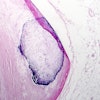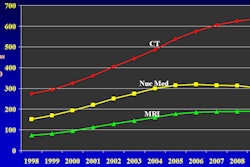CHICAGO - The use of CT in hospital emergency departments has increased at a higher rate than in other settings, which is bad news for associated radiation exposure, according to a study from Cincinnati Children's Hospital presented at the RSNA meeting.
The study was also published online today in Radiology (November 30, 2010).
David Larson, MD, and colleagues examined nationwide trends and factors associated with CT use in the emergency department using data from 1995 to 2007 National Hospital Ambulatory Medical Care Surveys. A mean of 30,044 visits were sampled for each year, and data were subcategorized according to multiple patient and hospital characteristics.
The team found that during the study time frame, the number of emergency room visits in which patients were imaged with CT increased 84% -- from 2.7 million to 16.2 million -- an average 16% increase per year. Of this growth, 3.3% was due to increased patient volume, while the remaining 12.7% was due to increased CT use, Larson said.
ED visits involving CT: 1995-2007 (in millions)
|
||||||||||||||||||||||||||
| Data courtesy of RSNA. |
The percentage of CT procedures in the emergency department grew from 2.8% in 1995 to 13.9% in 2007 -- a 4.9-fold increase, a compound annual growth rate of 14.2%, and a doubling time of 5.2 years, Larson said. CT use in the emergency department increased the most among patients 65 years of age and older, going from 6.6% in 1995 to 25.2% in 2007.
And by 2007, the end point of the study's time frame, overall use of CT had not reached an inflection point -- that is, when growth acceleration of a technology becomes negative, according to Larson.
"We did not find evidence that the increased use of CT in the emergency department was tapering," he said. "It's impossible to predict when or at what level the overall use of CT in the ED will begin to level off."
The growth partially reflects new uses for CT that were rarely used in 1995, such as side/flank imaging, abdominal imaging, and imaging for chest pain, Larson told attendees: By 2007, these indications were the most common for CT. Use of CT for side or flank pain went from 0.4% in 1995 to 43.3% in 2007; abdominal imaging went from 2% to 33%; and use of CT for chest pain increased from 1.2% to 13.7%.
This upswing in CT use means higher radiation dose in the patient population, Larson warned.
"Our study didn't directly address radiation dose, but the evidence suggests that CT-associated radiation exposure in the emergency department likely has increased even more rapidly than the number of CT examinations performed," he said.
Larson's team suggested that inappropriate CT use will decrease as more sophisticated and evidence-based decision models that address patient benefit from the exam are used at the time the decisions are made.
By Kate Madden Yee
AuntMinnie.com staff writer
November 30, 2010
Related Reading
U.S. children's hospitals reduce CT exam volume, April 29, 2010
CDC report: MRI, CT, PET use spikes in physician offices, ER, February 18, 2010
Studies spotlight high CT radiation dose, increased cancer risk, December 14, 2009
Study shows CT use has increased, diagnostic yield has not, March 3, 2009
CT utilization spikes among nonradiologists, December 17, 2008
Copyright © 2010 AuntMinnie.com





















